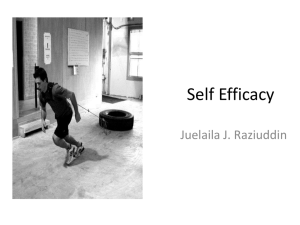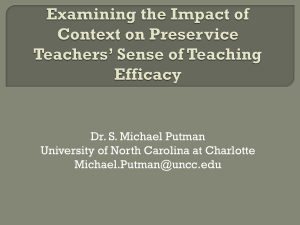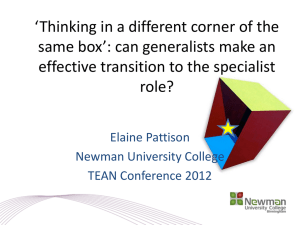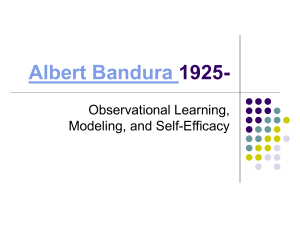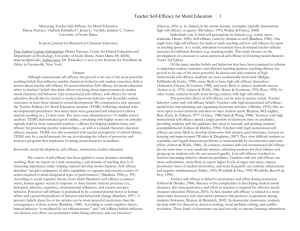Preservice Teachers* Knowledge and Self
advertisement
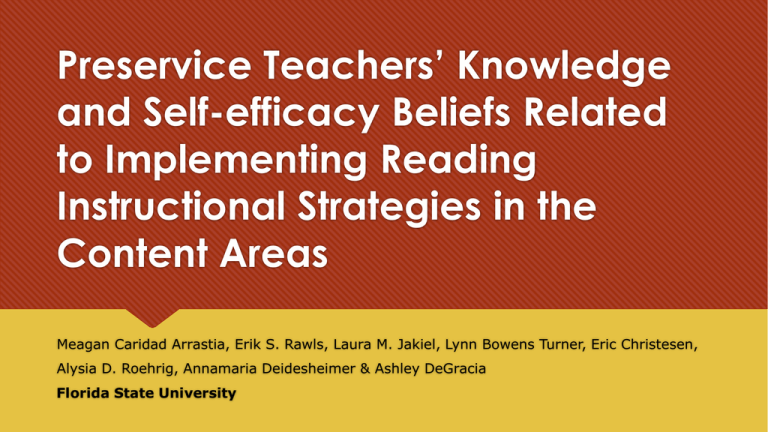
Preservice Teachers’ Knowledge and Self-efficacy Beliefs Related to Implementing Reading Instructional Strategies in the Content Areas Meagan Caridad Arrastia, Erik S. Rawls, Laura M. Jakiel, Lynn Bowens Turner, Eric Christesen, Alysia D. Roehrig, Annamaria Deidesheimer & Ashley DeGracia Florida State University Purpose The purpose of this study is to explore preservice secondary teachers’ (PTs) knowledge and self-efficacy beliefs related to implementing content-area reading instruction in their future practice. Why is this important? High Stakes Tests in Florida FCAT 2.0 Reading (less narrative texts): Grades 3-10 Math: Grades 3-8 Science: Grades 5 & 8 Writing: Grades 4, 8, & 10 End of Course Exams Algebra 1 Geometry U.S. History Biology Content-area Reading Content-area reading is “the ability to use reading and writing for the acquisition of new content in a given discipline” (McKenna & Robinson, 1990, p. 184). The focus is on learning from text The idea is not to read like a chemist, but to know how to study books (including chemistry books) Different from disciplinary literacy Theoretical Framework Self-efficacy is a teacher’s belief that he or she possesses both the ability and competence to complete a task (Bandura, 1977). From a social cognitive point-of-view, self-efficacy affects PTs’ goals and behaviors, which in turn are influenced by their environment (i.e., teacher-education program, internship, etc.) (Schunk & Meece, 2006). These beliefs affect how instructional opportunities and barriers are perceived (Bandura, 2006) and subsequently implementation of instruction, as well as the amount of effort is spent in preparation of the instruction, and perseverance in the face of obstacles (Pajares, 1997). Previous Research on PTs Nourie and Lenski (1998) found that PTs had a generally positive attitude towards content-area reading. But PTs generally admitted to using the strategies in a limited manner in the field (Akyol & Ulusoy, 2009). They feel inadequately prepared to teach their content area’s reading material to their students (Kane, 2007; McCoss-Yergian & Krepps, 2010; Stewart & O’Brien, 1989). Despite varying state requirements for content reading training (Come Romine, McKenna & Robinson, 1996), we identified no research on PTs’ perceived self-efficacy to implement reading strategies in their future content-area classrooms. Previous Research on Inservice Teachers A recent study (Cantrell & Callaway, 2008) found that practicing content-area teachers who included reading instruction in their curriculum reported significantly higher levels of personal efficacy efficacy (that he or she had the ability to influence student learning; Ashton & Webb, 1982), as well as collective collective efficacy efficacy (Goddard, Hoy, & Hoy, 2000) than their counterparts who hardly implemented reading instruction. High implementers more willing to overcome any barriers in order to deliver the instruction Through coaching and collaboration, the efficacy of both high and low implementers increased, but those that started out with higher efficacy were more likely to implement the new strategies in their classrooms (Cantrell & Hughes, 2008). Methods Convenience sample from 2 courses IRB approval & teacher permission Interviews: 12 junior/senior PTs Semi-structured protocol with both closed- and open-ended questions (Creswell, 2005) Questions about literacy instruction, implementation, reader biography, reflection, and the course Class Observations 3 hours/week for 1 month Course artifacts Final exams Grounded Theory Open Coded by 4 graduate students 5 interviews double-coded for inter-rater reliability calculated with Pearson correlation Constant comparison method Triangulation between observations, interviews, & exams Context Data collected at a large Southeastern university Required course for secondary PTs (English/Language Arts, Math, Science, and Social Studies) Course met once a week and included an online component (i.e., Blackboard discussion boards) Discussion posts/responses, journal entries/reflections, a midterm, and a final According to the syllabus: The goal is to help PTs focus on understanding the role of reading in their particular content areas, while developing the knowledge, skills, and attitudes to meet the reading needs of their future students. Reading strategies covered in the course: creative problem solving, reciprocal teaching, SQ3R, graphic and visual organizers, brainstorming, think alouds, mapping, journaling, etc. (e.g., Anderson & Pearson, 1984; Eanet & Manzo, 1976; Ogle, 1986; Rosenblatt, 1995). Results: Overview Four general themes emerged: 1. Medium efficacy for implementing strategies 2. Multiple barriers for developing efficacy and hardly any supports perceived 3. Various plans for implementing strategies in the future 4. Many perceived barriers for implementation and few known supports Inter-rater reliability: r = .70 for 5 interviews double-coded Results: Medium Efficacy Medium efficacy was defined as demonstrating efficacy for some strategies and reading instruction, but not others OR a stated average confidence for implementation. Different degrees of efficacy for different strategies, or for working with struggling students, and some were more specific in their descriptions and evaluations of their own abilities Ability to implement content-area strategies: “Comfortable. (laughs) Um, it’s going to be pretty difficult, but if I am using the strategy presented in the text, then I’ll be fine. Just like using echo—I mean echo reading or the reader theatre. I think those are techniques that can be used to, uh, help those students in reading orally or silently.” –P25 interview Results: Barriers for Developing Efficacy Barriers to Developing Efficacy Courses taught by English Education Instructors Focused on using trade books and graphic novels Focused on running records Completed instruction as students, not teachers Did the class prepare them? “It was interesting, but I don’t think it was focused on anything outside of English. I could see history or psychology in which you do a lot of reading. I mean everyone does a lot of reading in class, but having enough time to deal with all the reading. There were some strategies that would help students become better readers in the content area, but the running record and vowel games… I just don’t see myself taking the time to do that in my classes” –P1 interview Results: Future Implementation At least 1 strategy mentioned: P8 explained that he would use Tolkien’s The Hobbit in his 8th grade World History course and use “the SQ3R strategy and the use of embedded questions in a Socratic seminar-style discussion during and between lectures.” Another PT stated, “I think the pre-reading strategy is going to be pretty helpful… like giving out reading guides and ask[ing] students to retell the story after they finish…” –P2 interview “I plan to teach students to use context clues and reference materials…” –P7 final At times PTs could not express verbally the instructional strategies, but planned to help struggling students with reading: “If I see a student having a difficult time in my class, and my few strategies aren’t working, then I will alert the English teacher and say hey this kid needs extra help…” or “I can offer to help the kid after class, so we can work on reading and Biology at the same time.” –P7 interview Results: Barriers for Future Implementation Barriers to Implementation Instruction seems time consuming Unsure about explaining the reading process Anticipated diversity in reading instruction Easier to summarize material for struggling readers “Primarily the time issue. It would be really time consuming trying to get people who may be struggling with reading up to par with other students without sacrificing the rest of the class' learning gains with the actual content.” –P2 interview Discussion Spencer, Carter, Boon and Garcia-Simpson (2008) indicated that there is not enough being done to help content-area teachers “understand their role as teachers of reading” (p. 2). Taking a content-area reading undergraduate course may have a positive influence on their future students’ reading achievement (Bean & Readence, 1996; Kane, 2007). However, if PTs leave their teacher-education programs without the self-efficacy to implement reading strategies in the content areas, it is not likely that they will try to implement them, even if they value them Better understanding of how teacher-education programs can increase the literacy instruction efficacy of future content-area teachers Target identified barriers and bolster supports to develop self-efficacy for implementing content-area reading instruction Future Research Program Evaluation Longitudinal Research Sequencing of content-area reading course Efficacy to implement content-area reading instruction during first year of teaching and beyond Disciplinary Literacy Program Variables Who teaches the course? Who takes the course? When do they take the course? Thank you! Meagan Caridad Arrastia marrastia@fsu.edu References Anderson, R. C., & Pearson, P. D. (1984). A schema-theoretic view of basic processes in reading comprehension. In P. D. Pearson (Ed.), Handbook of reading research (pp. 255–292). New York: Longman. Akyol, H., & Ulusoy, M. (2009).Pre-service teachers' use of reading strategies in their own readings and future classrooms. Teaching and Teacher Education, 26(4), 878-884. Ashton, P. T., & Webb, R. B. (1982). Teacher's sense of efficacy: Toward an ecological model. Paper presented at the Annual meeting of the American Educational Research Association, New York, NY. Bandura, A. (1977). Self-efficacy: Toward a unifying theory of behavioral change. Psychological Review, 84(2), 191-215. doi:10.1037/0033-295X.84.2.191 Bandura, A. (2006). Adolescent development from an agentic perspective. In F. Pajares & T. Urdan (Eds.), Self-efficacy beliefs of adolescents (pp. 1-43). Greenwich, Connecticut: Information Age Publishing. doi:10.3102/00028312037002479 Kane, S. (2007). Literacy and learning in the content areas. 3rd ed. Scottsdale, AZ: Holcomb Hathaway. McCoss-Yergian, T., & Krepps, L. (2010). Do teacher attitudes impact literacy strategy implementation in content area classrooms? Journal of Instructional Pedagogies, 4, 1-18. Retrieved from http://search.proquest.com/docview/759652468?accountid=4840 Nourie, B., & Lenski, S. (1998). The (in)effectiveness of content area reading instruction. Clearing House, 71(6), 372-374. Retrieved from http://web.ebscohost.com/ehost/detail?hid=9&sid=b3a44a68-1c9a-4b729af28dae9cbe1da1%40sessionmgr14&vid=1&bdata=JnNpdGU9ZWhvc3QtbGl2ZQ%3d%3d#db=a9h&AN=7527 73 Bean, T., & Readence, J. (1996). Content area reading: The current state of the art. In Lapp, D., Flood, J., & Farnan, N. (Eds.), Content area reading and learning strategies (pp. 15-24). Needham Heights, MA: Allyn & Bacon. Ogle, D. M. (1986). K-W-L: A teaching model that develops active reading of expository test. The Reading Teacher, 39(6), 564-570. Pajares, F. (1997). Current directions in self-efficacy research. In H. W. Marsh, R. G. Craven, & D. M. McInerney (Eds.), International advances in self research (pp. 1-49). Greenwich, Connecticut: Information Age Publishing. Cantrell, S. C., & Callaway, P. (2008). High and low implementers of content reading instruction: Portraits of Teacher Efficacy. Teaching and Teacher Education, 24(7), 1739-1750. Cantrell, S. C. & Hughes, H. K. (2008). Teacher efficacy and content literacy implementation: An exploration of the effects of extended professional development with coaching. Journal of Literacy Research, 40, 95-127. Come Romine, B. G., McKenna M. C., & Robinson, R. D. (1996). Reading coursework requirements for middle and high school content area teachers: A U.S. survey. Journal of Adolescent & Adult Reading, 40(3), 194-198. Commeyras, M., Bisplinghoff, B.S., & Olson, J. (Eds.). (2003). Teachers as readers: Perspectives on the importance of reading in teachers' classrooms and lives. Newark, DE: International Reading Association. Stewart, R. A., & O’Brien, D. G. (1989).Resistance to content area reading: A focus on preservice teachers. Journal of Reading, 32(5), 396-401. Common Core. (2011). Retrieved from http://www.corestandards.org/the-standards/english-language-arts- standards Tschannen-Moran, M., & Hoy, A. W. (2001). Teacher efficacy: Capturing an elusive construct. Teaching and Teacher Education, 17(7), 783-805. doi:10.1016/S0742-051X(01)00036-1 Creswell, J. W. (2005). Educational research: Planning, conducting, and evaluating quantitative and qualitative research. Upper Saddle River, NJ: Pearson. Eanet, M.G., & Manzo, A.V. (1976). REAP--A strategy for improving reading/writing/study skills. Journal of Reading, 19, 647-652. Florida Department of Education. (2006). Legislative Requirements for Content Area Reading Professional Development. Retrieved from http://www.justreadflorida.com/CAR-PD/car-pd.pdf Goddard, R. D., Hoy, W. K., & Hoy, A. W. (2000). Collective teacher efficacy: Its meaning, measure, and impact on student achievement. American Educational Research Journal, 37(2), 479-507. Rosenblatt, L. M. (1994). The reader, the text, the poem: The transactional theory of the literary work. Carbondale: Southern Illinois University Press. Schunk, D. H., & Meece, J. L. (2006). Self-efficacy development in adolescence. In F. Pajares, & T. Urdan (Eds.), Self-efficacy beliefs of adolescents (pp. 71-96). Greenwich, Connecticut: Information Age Publishing. Spencer, V. G., Carter, B. B., Boon, R. T., & Garcia-Simpson, C. (2008). If you teach-you teach reading. International Journal of Special Education, 23(2), 1-7.


